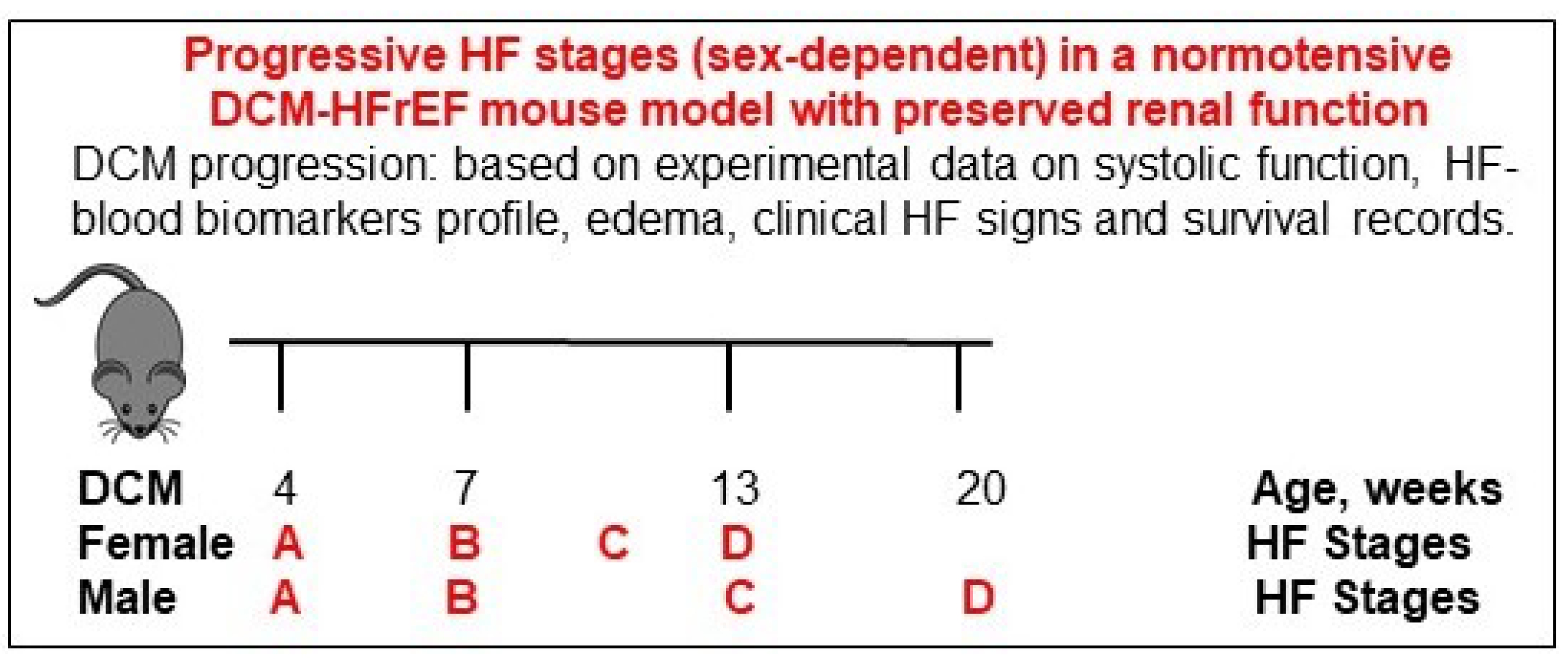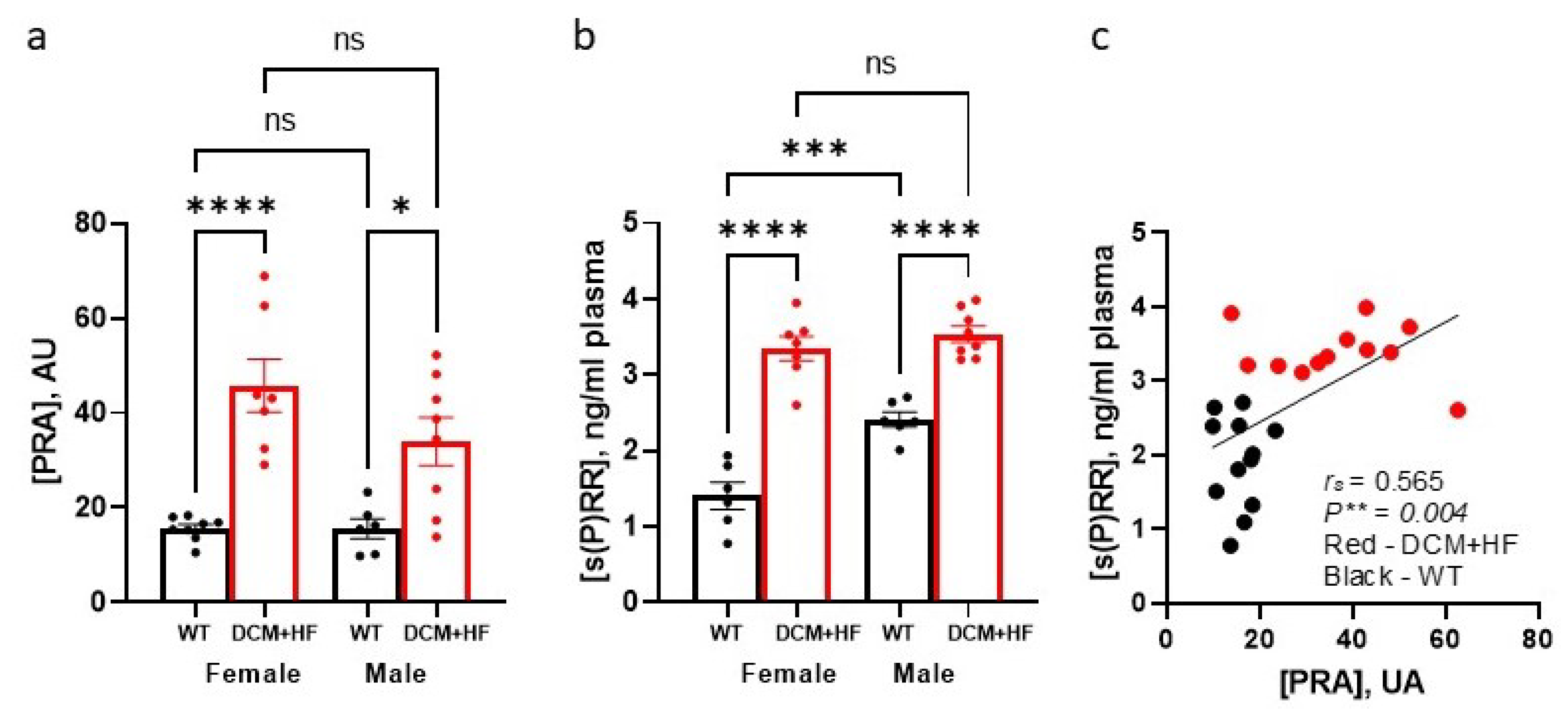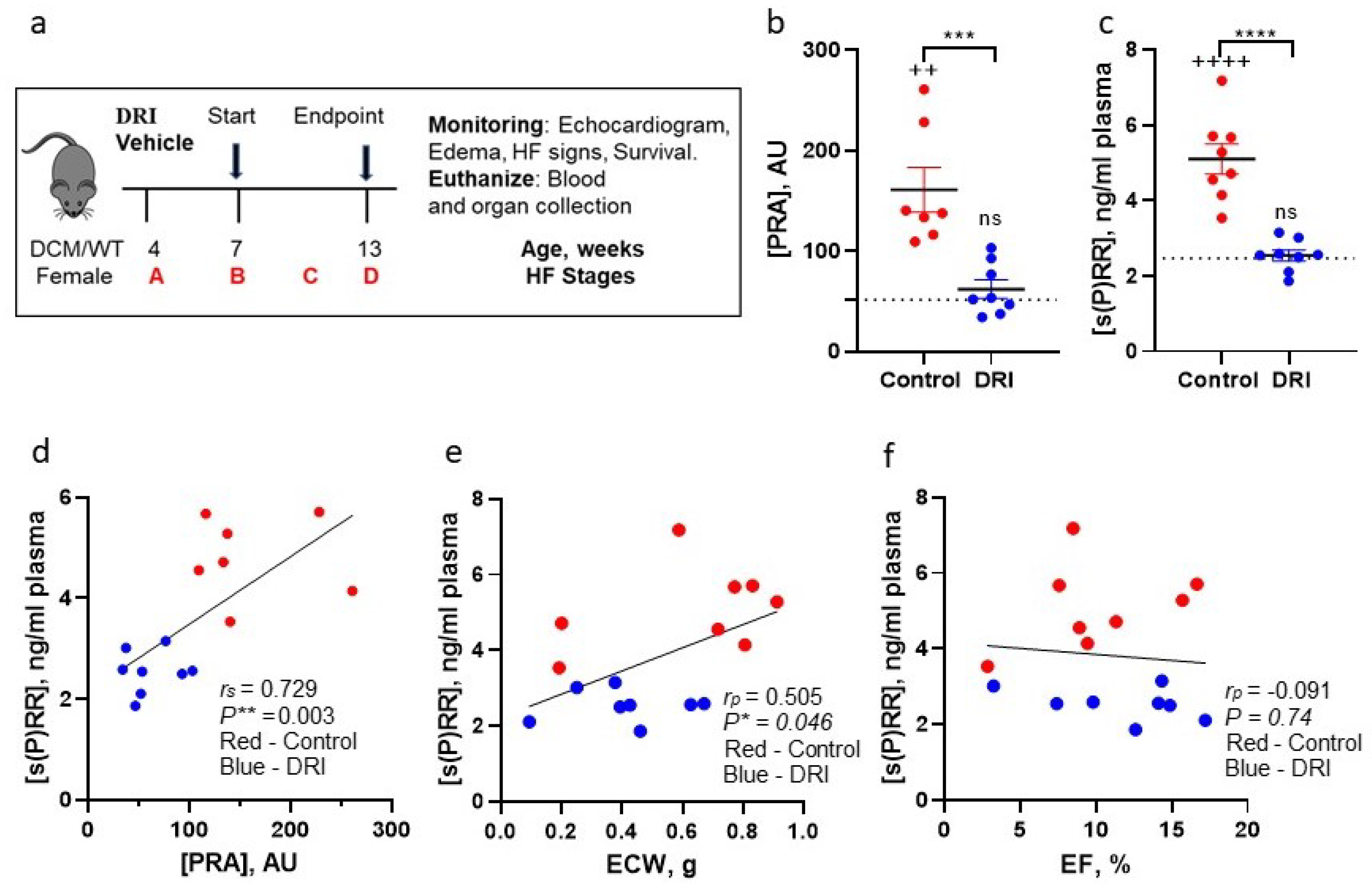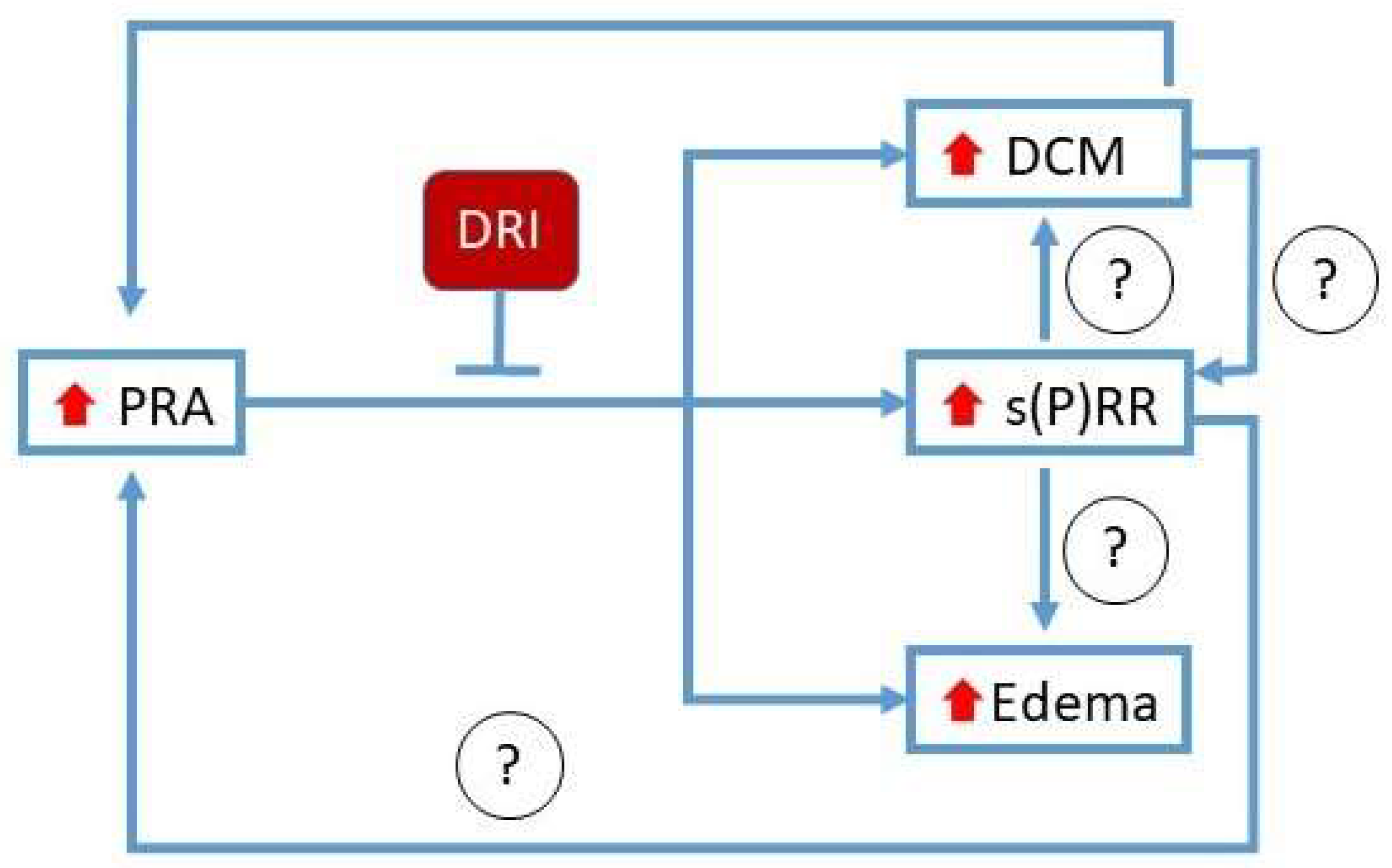Soluble (Pro)Renin Receptor Levels Are Regulated by Plasma Renin Activity and Correlated with Edema in Mice and Humans with HFrEF
Abstract
:1. Introduction
2. Materials and Methods
2.1. Study Population
2.2. Mouse Model of DCM-HFrEF
2.3. Blood Sample Collection
2.4. Plasma Biomarker Measurements
2.5. Extracellular Water Analysis
2.6. Echocardiography
2.7. Statistical Analysis
3. Results
3.1. Plasma s(P)RR Levels Elevate as Clinical HFrEF Progress and Positively Correlate with PRA
3.2. Association between Plasma s(P)RR and PRA Levels in DCM-HFrEF Mouse Model
3.3. Normalization of PRA with Direct Renin Inhibitor Normalizes Plasma s(P)RR Levels in DCM-HFrEF Mice
4. Discussion
5. Conclusions
6. Patents
Author Contributions
Funding
Institutional Review Board Statement
Informed Consent Statement
Data Availability Statement
Acknowledgments
Conflicts of Interest
References
- Weintraub, R.G.; Semsarian, C.; Macdonald, P. Dilated Cardiomyopathy. Lancet 2017, 390, 400–414. [Google Scholar] [CrossRef]
- Schultheiss, H.P.; Fairweather, D.; Caforio, A.L.P.; Escher, F.; Hershberger, R.E.; Lipshultz, S.E.; Liu, P.P.; Matsumori, A.; Mazzanti, A.; McMurray, J.; et al. Dilated Cardiomyopathy. Nat. Rev. Dis. Primers 2019, 5, 32. [Google Scholar] [CrossRef] [PubMed]
- Rosenbaum, A.N.; Agre, K.E.; Pereira, N.L. Genetics of Dilated Cardiomyopathy: Practical Implications for Heart Failure Management. Nat. Rev. Cardiol. 2020, 17, 286–297. [Google Scholar] [CrossRef] [PubMed]
- Vaduganathan, M.; Claggett, B.L.; Jhund, P.S.; Cunningham, J.W.; Pedro Ferreira, J.; Zannad, F.; Packer, M.; Fonarow, G.C.; McMurray, J.J.V.; Solomon, S.D. Estimating Lifetime Benefits of Comprehensive Disease-Modifying Pharmacological Therapies in Patients with Heart Failure with Reduced Ejection Fraction: A Comparative Analysis of Three Randomised Controlled Trials. Lancet 2020, 396, 121–128. [Google Scholar] [CrossRef]
- McMurray, J.J.V.; Packer, M. How Should We Sequence the Treatments for Heart Failure and a Reduced Ejection Fraction? A Redefinition of Evidence-Based Medicine. Circulation 2021, 143, 875–877. [Google Scholar] [CrossRef] [PubMed]
- McDonagh, T.A.; Metra, M.; Adamo, M.; Gardner, R.S.; Baumbach, A.; Bohm, M.; Burri, H.; Butler, J.; Celutkiene, J.; Chioncel, O.; et al. 2021 Esc Guidelines for the Diagnosis and Treatment of Acute and Chronic Heart Failure. Eur. Heart J. 2021, 42, 3599–3726. [Google Scholar] [CrossRef] [PubMed]
- Hernandez, M.; Sullivan, R.D.; McCune, M.E.; Reed, G.L.; Gladysheva, I.P. Sodium-Glucose Cotransporter-2 Inhibitors Improve Heart Failure with Reduced Ejection Fraction Outcomes by Reducing Edema and Congestion. Diagnostics 2022, 12, 989. [Google Scholar] [CrossRef]
- Yancy, C.W.; Jessup, M.; Bozkurt, B.; Butler, J.; Casey, D.E., Jr.; Drazner, M.H.; Fonarow, G.C.; Geraci, S.A.; Horwich, T.; Januzzi, J.L.; et al. 2013 Accf/Aha Guideline for the Management of Heart Failure: Executive Summary: A Report of the American College of Cardiology Foundation/American Heart Association Task Force on Practice Guidelines. Circulation 2013, 128, 1810–1852. [Google Scholar] [CrossRef] [PubMed]
- Bozkurt, B.; Coats, A.J.S.; Tsutsui, H.; Abdelhamid, C.M.; Adamopoulos, S.; Albert, N.; Anker, S.D.; Atherton, J.; Bohm, M.; Butler, J.; et al. Universal Definition and Classification of Heart Failure: A Report of the Heart Failure Society of America, Heart Failure Association of the European Society of Cardiology, Japanese Heart Failure Society and Writing Committee of the Universal Definition of Heart Failure: Endorsed by the Canadian Heart Failure Society, Heart Failure Association of India, Cardiac Society of Australia and New Zealand, and Chinese Heart Failure Association. Eur. J. Heart Fail. 2021, 23, 352–380. [Google Scholar] [CrossRef]
- Heidenreich, P.A.; Bozkurt, B.; Aguilar, D.; Allen, L.A.; Byun, J.J.; Colvin, M.M.; Deswal, A.; Drazner, M.H.; Dunlay, S.M.; Evers, L.R.; et al. 2022 Aha/Acc/Hfsa Guideline for the Management of Heart Failure: Executive Summary: A Report of the American College of Cardiology/American Heart Association Joint Committee on Clinical Practice Guidelines. Circulation 2022, 79, 1757–1780. [Google Scholar] [CrossRef] [PubMed]
- Dzau, V.J.; Colucci, W.S.; Hollenberg, N.K.; Williams, G.H. Relation of the Renin-Angiotensin-Aldosterone System to Clinical State in Congestive Heart Failure. Circulation 1981, 63, 645–651. [Google Scholar] [CrossRef] [PubMed] [Green Version]
- Schrier, R.W.; Abraham, W.T. Hormones and Hemodynamics in Heart Failure. N. Engl. J. Med. 1999, 341, 577–585. [Google Scholar] [CrossRef] [PubMed]
- Ibebuogu, U.N.; Gladysheva, I.P.; Houng, A.K.; Reed, G.L. Decompensated Heart Failure Is Associated with Reduced Corin Levels and Decreased Cleavage of Pro-Atrial Natriuretic Peptide. Cardiocirc. Heart Fail. 2011, 4, 114–120. [Google Scholar] [CrossRef] [Green Version]
- Dries, D.L. Process Matters: Emerging Concepts Underlying Impaired Natriuretic Peptide System Function in Heart Failure. Cardiocirc. Heart Fail. 2011, 4, 107–110. [Google Scholar] [CrossRef] [PubMed] [Green Version]
- Patel, V.B.; Zhong, J.C.; Grant, M.B.; Oudit, G.Y. Role of the Ace2/Angiotensin 1-7 Axis of the Renin-Angiotensin System in Heart Failure. Cardiocirc. Res. 2016, 118, 1313–1326. [Google Scholar] [CrossRef] [PubMed] [Green Version]
- Hartupee, J.; Mann, D.L. Neurohormonal Activation in Heart Failure with Reduced Ejection Fraction. Nat. Rev. Cardiol. 2017, 14, 30–38. [Google Scholar] [CrossRef] [Green Version]
- Zaidi, S.S.; Ward, R.D.; Ramanathan, K.; Yu, X.; Gladysheva, I.P.; Reed, G.L. Possible Enzymatic Downregulation of the Natriuretic Peptide System in Patients with Reduced Systolic Function and Heart Failure: A Pilot Study. BioMed Res. Int. 2018, 2018, 7279036. [Google Scholar] [CrossRef] [PubMed] [Green Version]
- Sullivan, R.D.; Mehta, R.M.; Tripathi, R.; Reed, G.L.; Gladysheva, I.P. Renin Activity in Heart Failure with Reduced Systolic Function-New Insights. Int. J. Mol. Sci. 2019, 20, 3182. [Google Scholar] [CrossRef] [Green Version]
- Tripathi, R.; Sullivan, R.D.; Fan, T.M.; Mehta, R.M.; Gladysheva, I.P.; Reed, G.L. A Low-Sodium Diet Boosts Ang (1-7) Production and No-Cgmp Bioavailability to Reduce Edema and Enhance Survival in Experimental Heart Failure. Int. J. Mol. Sci. 2021, 22, 4035. [Google Scholar] [CrossRef] [PubMed]
- Nguyen, G.; Delarue, F.; Burckle, C.; Bouzhir, L.; Giller, T.; Sraer, J.D. Pivotal Role of the Renin/Prorenin Receptor in Angiotensin Ii Production and Cellular Responses to Renin. J. Clin. Investig. 2002, 109, 1417–1427. [Google Scholar] [CrossRef] [PubMed]
- Ichihara, A.; Yatabe, M.S. The (Pro)Renin Receptor in Health and Disease. Nat. Rev. Nephrol. 2019, 15, 693–712. [Google Scholar] [CrossRef] [PubMed]
- Quadri, S.S.; Cooper, C.; Ghaffar, D.; Vaishnav, H.; Nahar, L. The Pathological Role of Pro(Renin) Receptor in Renal Inflammation. J. Exp. Pharmacol. 2021, 13, 339–344. [Google Scholar] [CrossRef] [PubMed]
- Xu, C.; Liu, C.; Xiong, J.; Yu, J. Cardiovascular Aspects of the (Pro)Renin Receptor: Function and Significance. FASEB J. 2022, 36, e22237. [Google Scholar] [CrossRef] [PubMed]
- Cousin, C.; Bracquart, D.; Contrepas, A.; Corvol, P.; Muller, L.; Nguyen, G. Soluble Form of the (Pro)Renin Receptor Generated by Intracellular Cleavage by Furin Is Secreted in Plasma. Hypertension 2009, 53, 1077–1082. [Google Scholar] [CrossRef] [Green Version]
- Yoshikawa, A.; Aizaki, Y.; Kusano, K.; Kishi, F.; Susumu, T.; Iida, S.; Ishiura, S.; Nishimura, S.; Shichiri, M.; Senbonmatsu, T. The (Pro)Renin Receptor Is Cleaved by Adam19 in the Golgi Leading to Its Secretion into Extracellular Space. Hypertens. Res. 2011, 34, 599–605. [Google Scholar] [CrossRef] [Green Version]
- Morimoto, S.; Ando, T.; Niiyama, M.; Seki, Y.; Yoshida, N.; Watanabe, D.; Kawakami-Mori, F.; Kobori, H.; Nishiyama, A.; Ichihara, A. Serum Soluble (Pro)Renin Receptor Levels in Patients with Essential Hypertension. Hypertens. Res. 2014, 37, 642–648. [Google Scholar] [CrossRef] [Green Version]
- Gonzalez, A.A.; Lara, L.S.; Luffman, C.; Seth, D.M.; Prieto, M.C. Soluble Form of the (Pro)Renin Receptor Is Augmented in the Collecting Duct and Urine of Chronic Angiotensin Ii-Dependent Hypertensive Rats. Hypertension 2011, 57, 859–864. [Google Scholar] [CrossRef] [Green Version]
- Biswas, K.B.; Nabi, A.H.; Arai, Y.; Nakagawa, T.; Ebihara, A.; Ichihara, A.; Watanabe, T.; Inagami, T.; Suzuki, F. Aliskiren Binds to Renin and Prorenin Bound to (Pro)Renin Receptor in Vitro. Hypertens. Res. 2010, 33, 1053–1059. [Google Scholar] [CrossRef] [Green Version]
- Amari, Y.; Morimoto, S.; Iida, T.; Takimoto, H.; Okuda, H.; Yurugi, T.; Oyama, Y.; Aoyama, N.; Nakajima, F.; Ichihara, A. Association between Serum Soluble (Pro)Renin Receptor Level and Worsening of Cardiac Function in Hemodialysis Patients: A Prospective Observational Study. PLoS ONE 2020, 15, e0233312. [Google Scholar] [CrossRef]
- Obradovic, D.; Loncar, G.; Radenovic, S.; Tahirovic, E.; Heidecke, H.; Schulze-Forster, K.; Muller, D.; Busjahn, A.; Buttner, P.; Veskovic, J.; et al. Soluble (Pro)Renin Receptor in Elderly Chronic Heart Failure Patients. Front. Biosci. (Landmark Ed) 2020, 25, 1839–1853. [Google Scholar] [CrossRef]
- Fukushima, A.; Kinugawa, S.; Homma, T.; Masaki, Y.; Furihata, T.; Abe, T.; Suga, T.; Takada, S.; Kadoguchi, T.; Okita, K.; et al. Increased Plasma Soluble (Pro)Renin Receptor Levels Are Correlated with Renal Dysfunction in Patients with Heart Failure. Int. J. Cardiol. 2013, 168, 4313–4314. [Google Scholar] [CrossRef] [PubMed]
- Gong, L.; Zhang, S.; Li, L.; Gao, X.; Wang, D.; Wu, D.; Wang, K.; Liu, Y. Elevated Plasma Soluble (Pro)Renin Receptor Levels Are Associated with Left Ventricular Remodeling and Renal Function in Chronic Heart Failure Patients with Reduced Ejection Fraction. Peptides 2019, 111, 152–157. [Google Scholar] [CrossRef]
- Ikeda, Y.; Tsutsui, K.; Yamada, Y.; Kato, R.; Muramatsu, T.; Senbonmatsu, T. Relationship between Soluble (Pro)Renin Receptor and Renin Activity in Patients with Severe Heart Failure. J. Clin. Med. 2020, 9, 4110. [Google Scholar] [CrossRef] [PubMed]
- Fentzke, R.C.; Korcarz, C.E.; Lang, R.M.; Lin, H.; Leiden, J.M. Dilated Cardiomyopathy in Transgenic Mice Expressing a Dominant-Negative Creb Transcription Factor in the Heart. J. Clin. Investig. 1998, 101, 2415–2426. [Google Scholar] [CrossRef] [PubMed]
- Watson, P.A.; Birdsey, N.; Huggins, G.S.; Svensson, E.; Heppe, D.; Knaub, L. Cardiac-Specific Overexpression of Dominant-Negative Creb Leads to Increased Mortality and Mitochondrial Dysfunction in Female Mice. Am. J. Physiol. Heart Circ. Physiol. 2010, 299, H2056–H2068. [Google Scholar] [CrossRef] [PubMed] [Green Version]
- Gladysheva, I.P.; Wang, D.; McNamee, R.A.; Houng, A.K.; Mohamad, A.A.; Fan, T.M.; Reed, G.L. Corin Overexpression Improves Cardiac Function, Heart Failure, and Survival in Mice with Dilated Cardiomyopathy. Hypertension 2013, 61, 327–332. [Google Scholar] [CrossRef] [PubMed] [Green Version]
- Wang, D.; Gladysheva, I.P.; Fan, T.H.; Sullivan, R.; Houng, A.K.; Reed, G.L. Atrial Natriuretic Peptide Affects Cardiac Remodeling, Function, Heart Failure, and Survival in a Mouse Model of Dilated Cardiomyopathy. Hypertension 2014, 63, 514–519. [Google Scholar] [CrossRef] [PubMed] [Green Version]
- Tripathi, R.; Wang, D.; Sullivan, R.; Fan, T.H.; Gladysheva, I.P.; Reed, G.L. Depressed Corin Levels Indicate Early Systolic Dysfunction before Increases of Atrial Natriuretic Peptide/B-Type Natriuretic Peptide and Heart Failure Development. Hypertension 2016, 67, 362–367. [Google Scholar] [CrossRef] [PubMed] [Green Version]
- Tripathi, R.; Sullivan, R.; Fan, T.M.; Wang, D.; Sun, Y.; Reed, G.L.; Gladysheva, I.P. Enhanced Heart Failure, Mortality and Renin Activation in Female Mice with Experimental Dilated Cardiomyopathy. PLoS ONE 2017, 12, e0189315. [Google Scholar] [CrossRef] [PubMed] [Green Version]
- Sullivan, R.D.; Mehta, R.M.; Tripathi, R.; Gladysheva, I.P.; Reed, G.L. Normalizing Plasma Renin Activity in Experimental Dilated Cardiomyopathy: Effects on Edema, Cachexia, and Survival. Int. J. Mol. Sci. 2019, 20, 3886. [Google Scholar] [CrossRef] [PubMed] [Green Version]
- Tripathi, R.; Sullivan, R.D.; Fan, T.M.; Houng, A.K.; Mehta, R.M.; Reed, G.L.; Gladysheva, I.P. Cardiac-Specific Overexpression of Catalytically Inactive Corin Reduces Edema, Contractile Dysfunction, and Death in Mice with Dilated Cardiomyopathy. Int. J. Mol. Sci. 2020, 21, 203. [Google Scholar] [CrossRef] [PubMed] [Green Version]
- Tripathi, R.; Sullivan, R.D.; Fan, T.M.; Mehta, R.M.; Gladysheva, I.P.; Reed, G.L. In Experimental Dilated Cardiomyopathy Heart Failure and Survival Are Adversely Affected by a Lack of Sexual Interactions. Int. J. Mol. Sci. 2020, 21, 5450. [Google Scholar] [CrossRef] [PubMed]
- Schefold, J.C.; Filippatos, G.; Hasenfuss, G.; Anker, S.D.; von Haehling, S. Heart Failure and Kidney Dysfunction: Epidemiology, Mechanisms and Management. Nat. Rev. Nephrol. 2016, 12, 610–623. [Google Scholar] [CrossRef] [PubMed]
- Damman, K.; Masson, S.; Lucci, D.; Gorini, M.; Urso, R.; Maggioni, A.P.; Tavazzi, L.; Tarantini, L.; Tognoni, G.; Voors, A.; et al. Progression of Renal Impairment and Chronic Kidney Disease in Chronic Heart Failure: An Analysis from Gissi-Hf. J. Card. Fail. 2017, 23, 2–9. [Google Scholar] [CrossRef] [Green Version]
- Adamska-Welnicka, A.; Welnicki, M.; Mamcarz, A.; Gellert, R. Chronic Kidney Disease and Heart Failure-Everyday Diagnostic Challenges. Diagnostics 2021, 11, 2164. [Google Scholar] [CrossRef] [PubMed]
- Rachwan, R.J.; Butler, J.; Collins, S.P.; Cotter, G.; Davison, B.A.; Senger, S.; Ezekowitz, J.A.; Filippatos, G.; Levy, P.D.; Metra, M.; et al. Is Plasma Renin Activity Associated with Worse Outcomes in Acute Heart Failure? A Secondary Analysis from the Blast-Ahf Trial. Eur. J. Heart Fail. 2019, 21, 1561–1570. [Google Scholar] [CrossRef] [PubMed]
- Nguyen, G.; Blanchard, A.; Curis, E.; Bergerot, D.; Chambon, Y.; Hirose, T.; Caumont-Prim, A.; Tabard, S.B.; Baron, S.; Frank, M.; et al. Plasma Soluble (Pro)Renin Receptor Is Independent of Plasma Renin, Prorenin, and Aldosterone Concentrations but Is Affected by Ethnicity. Hypertension 2014, 63, 297–302. [Google Scholar] [CrossRef] [Green Version]
- Miyaoka, T.; Morimoto, S.; Kataoka, H.; Mochizuki, T.; Tsuchiya, K.; Ichihara, A.; Nitta, K. Serum Soluble (Pro) Renin Receptor Level Is Increased in Association with.Impaired Renal Function in Patients with Autosomal Dominant Polcystic Kidney.Disease. J. Clin. Exp. Nephrol. 2018, 3, 2. [Google Scholar] [CrossRef]
- Sullivan, R.D.; Mehta, R.M.; Tripathi, R.; Gladysheva, I.P.; Reed, G.L. Targeting Renin Activity in Heart Failure: Precision Therapy with Aliskiren Improves Systolic Function and Prolongs Survival in Female Experimental Dilated Cardiomyopathy. Circulation 2018, 138, A16743. [Google Scholar]
- Lu, X.; Wang, F.; Xu, C.; Soodvilai, S.; Peng, K.; Su, J.; Zhao, L.; Yang, K.T.; Feng, Y.; Zhou, S.F.; et al. Soluble (Pro)Renin Receptor Via Beta-Catenin Enhances Urine Concentration Capability as a Target of Liver X Receptor. Proc. Natl. Acad. Sci. USA 2016, 113, E1898–E1906. [Google Scholar] [CrossRef] [PubMed] [Green Version]
- Wang, F.; Xu, C.; Luo, R.; Peng, K.; Ramkumar, N.; Xie, S.; Lu, X.; Zhao, L.; Zuo, C.J.; Kohan, D.E.; et al. Site-1 Protease-Derived Soluble (Pro)Renin Receptor Targets Vasopressin Receptor 2 to Enhance Urine Concentrating Capability. JCI Insight 2019, 4, e124174. [Google Scholar] [CrossRef] [PubMed]
- Mahmud, H.; Sillje, H.H.; Cannon, M.V.; van Gilst, W.H.; de Boer, R.A. Regulation of the (Pro)Renin-Renin Receptor in Cardiac Remodelling. J. Cell Mol. Med. 2012, 16, 722–729. [Google Scholar] [CrossRef] [Green Version]
- Hirose, T.; Mori, N.; Totsune, K.; Morimoto, R.; Maejima, T.; Kawamura, T.; Metoki, H.; Asayama, K.; Kikuya, M.; Ohkubo, T.; et al. Gene Expression of (Pro)Renin Receptor Is Upregulated in Hearts and Kidneys of Rats with Congestive Heart Failure. Peptides 2009, 30, 2316–2322. [Google Scholar] [CrossRef]
- Peng, H.; Wu, Z.B.; Kong, S.S.; Li, L. Role of (Pro)Rennin Receptor in Cardiomyocytes of Heart Failure Rat Model. J. Huazhong Univ. Sci. Technol. Med. Sci. 2013, 33, 640–643. [Google Scholar] [CrossRef] [PubMed]
- Kinouchi, K.; Ichihara, A.; Sano, M.; Sun-Wada, G.H.; Wada, Y.; Kurauchi-Mito, A.; Bokuda, K.; Narita, T.; Oshima, Y.; Sakoda, M.; et al. The (Pro)Renin Receptor/Atp6ap2 Is Essential for Vacuolar H+-Atpase Assembly in Murine Cardiomyocytes. Circ. Res. 2010, 107, 30–34. [Google Scholar] [CrossRef] [Green Version]
- Moilanen, A.M.; Rysa, J.; Serpi, R.; Mustonen, E.; Szabo, Z.; Aro, J.; Napankangas, J.; Tenhunen, O.; Sutinen, M.; Salo, T.; et al. (Pro)Renin Receptor Triggers Distinct Angiotensin Ii-Independent Extracellular Matrix Remodeling and Deterioration of Cardiac Function. PLoS ONE 2012, 7, e41404. [Google Scholar] [CrossRef]
- Cao, X.; Yu, S.; Wang, Y.; Yang, M.; Xiong, J.; Yuan, H.; Dong, B. Effects of the (Pro)Renin Receptor on Cardiac Remodeling and Function in a Rat Alcoholic Cardiomyopathy Model Via the Prr-Erk1/2-Nox4 Pathway. Oxidative Med. Cell. Longev. 2019, 2019, 4546975. [Google Scholar] [CrossRef]
- Xiong, J.; Cao, X.; Qiao, S.; Yu, S.; Li, L.; Yu, Y.; Fu, C.; Jiang, F.; Dong, B.; Su, Q. (Pro)Renin Receptor Is Involved in Myocardial Damage in Alcoholic Cardiomyopathy. Alcohol Clin. Exp. Res. 2019, 43, 2344–2353. [Google Scholar] [CrossRef] [PubMed]
- Xiong, J.; Dong, X.; Li, S.; Jiang, F.; Chen, J.; Yu, S.; Dong, B.; Su, Q. Effects of (Pro)Renin Receptor on Diabetic Cardiomyopathy Pathological Processes in Rats Via the Prr-Ampk-Yap Pathway. Front. Physiol. 2021, 12, 657378. [Google Scholar] [CrossRef] [PubMed]
- Yu, S.; Dong, X.; Yang, M.; Yu, Q.; Xiong, J.; Chen, J.; Dong, B.; Su, Q. (Pro)Renin Receptor Involves in Myocardial Fibrosis and Oxidative Stress in Diabetic Cardiomyopathy Via the Prr-Yap Pathway. Sci. Rep. 2021, 11, 3259. [Google Scholar] [CrossRef] [PubMed]
- Connelly, K.A.; Advani, A.; Kim, S.; Advani, S.L.; Zhang, M.; White, K.E.; Kim, Y.M.; Parker, C.; Thai, K.; Krum, H.; et al. The Cardiac (Pro)Renin Receptor Is Primarily Expressed in Myocyte Transverse Tubules and Is Increased in Experimental Diabetic Cardiomyopathy. J. Hypertens. 2011, 29, 1175–1184. [Google Scholar] [CrossRef]
- Feldman, D.L.; Jin, L.; Xuan, H.; Contrepas, A.; Zhou, Y.; Webb, R.L.; Mueller, D.N.; Feldt, S.; Cumin, F.; Maniara, W.; et al. Effects of Aliskiren on Blood Pressure, Albuminuria, and (Pro)Renin Receptor Expression in Diabetic Tg(Mren-2)27 Rats. Hypertension 2008, 52, 130–136. [Google Scholar] [CrossRef] [Green Version]





Publisher’s Note: MDPI stays neutral with regard to jurisdictional claims in published maps and institutional affiliations. |
© 2022 by the authors. Licensee MDPI, Basel, Switzerland. This article is an open access article distributed under the terms and conditions of the Creative Commons Attribution (CC BY) license (https://creativecommons.org/licenses/by/4.0/).
Share and Cite
Gladysheva, I.P.; Sullivan, R.D.; Ramanathan, K.; Reed, G.L. Soluble (Pro)Renin Receptor Levels Are Regulated by Plasma Renin Activity and Correlated with Edema in Mice and Humans with HFrEF. Biomedicines 2022, 10, 1874. https://doi.org/10.3390/biomedicines10081874
Gladysheva IP, Sullivan RD, Ramanathan K, Reed GL. Soluble (Pro)Renin Receptor Levels Are Regulated by Plasma Renin Activity and Correlated with Edema in Mice and Humans with HFrEF. Biomedicines. 2022; 10(8):1874. https://doi.org/10.3390/biomedicines10081874
Chicago/Turabian StyleGladysheva, Inna P., Ryan D. Sullivan, Kodangudi Ramanathan, and Guy L. Reed. 2022. "Soluble (Pro)Renin Receptor Levels Are Regulated by Plasma Renin Activity and Correlated with Edema in Mice and Humans with HFrEF" Biomedicines 10, no. 8: 1874. https://doi.org/10.3390/biomedicines10081874





